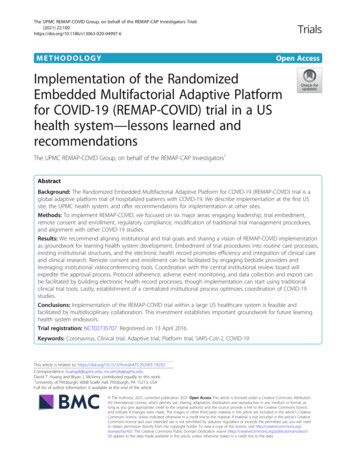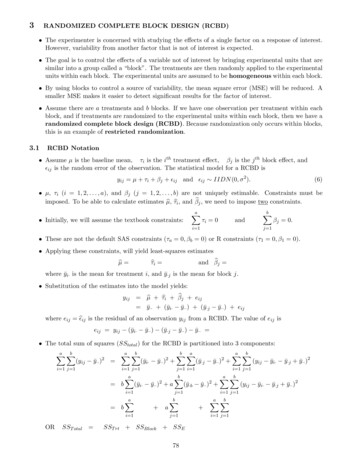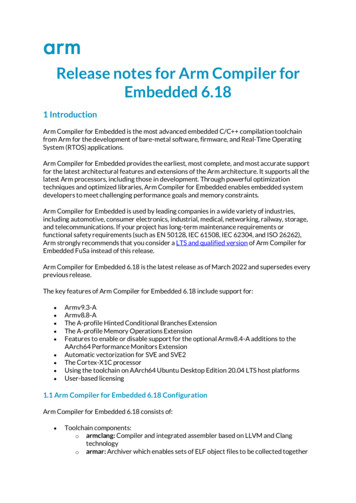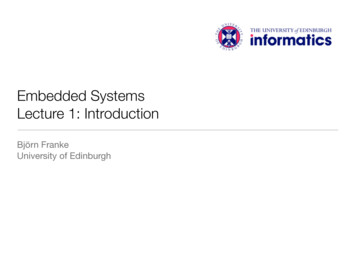
Transcription
The UPMC REMAP-COVID Group, on behalf of the REMAP-CAP Investigators Trials(2021) THODOLOGYOpen AccessImplementation of the RandomizedEmbedded Multifactorial Adaptive Platformfor COVID-19 (REMAP-COVID) trial in a UShealth system—lessons learned andrecommendationsThe UPMC REMAP-COVID Group, on behalf of the REMAP-CAP Investigators1AbstractBackground: The Randomized Embedded Multifactorial Adaptive Platform for COVID-19 (REMAP-COVID) trial is aglobal adaptive platform trial of hospitalized patients with COVID-19. We describe implementation at the first USsite, the UPMC health system, and offer recommendations for implementation at other sites.Methods: To implement REMAP-COVID, we focused on six major areas: engaging leadership, trial embedment,remote consent and enrollment, regulatory compliance, modification of traditional trial management procedures,and alignment with other COVID-19 studies.Results: We recommend aligning institutional and trial goals and sharing a vision of REMAP-COVID implementationas groundwork for learning health system development. Embedment of trial procedures into routine care processes,existing institutional structures, and the electronic health record promotes efficiency and integration of clinical careand clinical research. Remote consent and enrollment can be facilitated by engaging bedside providers andleveraging institutional videoconferencing tools. Coordination with the central institutional review board willexpedite the approval process. Protocol adherence, adverse event monitoring, and data collection and export canbe facilitated by building electronic health record processes, though implementation can start using traditionalclinical trial tools. Lastly, establishment of a centralized institutional process optimizes coordination of COVID-19studies.Conclusions: Implementation of the REMAP-COVID trial within a large US healthcare system is feasible andfacilitated by multidisciplinary collaboration. This investment establishes important groundwork for future learninghealth system endeavors.Trial registration: NCT02735707. Registered on 13 April 2016.Keywords: Coronavirus, Clinical trial, Adaptive trial, Platform trial, SARS-CoV-2, COVID-19This article is related to: respondence: huangdt@upmc.edu; mcverrybj@upmc.eduDavid T. Huang and Bryan J. McVerry contributed equally to this work.1University of Pittsburgh, 606B Scaife Hall, Pittsburgh, PA 15213, USAFull list of author information is available at the end of the article The Author(s). 2021, corrected publication 2021. Open Access This article is licensed under a Creative Commons Attribution4.0 International License, which permits use, sharing, adaptation, distribution and reproduction in any medium or format, aslong as you give appropriate credit to the original author(s) and the source, provide a link to the Creative Commons licence,and indicate if changes were made. The images or other third party material in this article are included in the article's CreativeCommons licence, unless indicated otherwise in a credit line to the material. If material is not included in the article's CreativeCommons licence and your intended use is not permitted by statutory regulation or exceeds the permitted use, you will needto obtain permission directly from the copyright holder. To view a copy of this licence, visit http://creativecommons.org/licenses/by/4.0/. The Creative Commons Public Domain Dedication waiver ) applies to the data made available in this article, unless otherwise stated in a credit line to the data.
The UPMC REMAP-COVID Group, on behalf of the REMAP-CAP Investigators TrialsA Randomized Embedded Multifactorial Adaptive Platform (REMAP) trial combines features of adaptive platform and pragmatic point-of-care trials to simultaneouslyevaluate multiple treatment strategies and maximize trialconduct efficiency [1, 2].REMAP-CAP is a global adaptive platform trial of patients with severe community-acquired pneumonia(CAP) admitted to the intensive care unit (ICU) that waslaunched in 2016 [3]. The trial design and rationale havebeen previously published [4]. Briefly, REMAP-CAP isgoverned by an International Trial Steering Committee(ITSC) and uses a core protocol that defines broad eligibility criteria, outcomes, and the statistical analysis plan.Multiple investigational treatments are layered withinthe core protocol as “domains”. Domains test investigational treatments with similar mechanisms of action, andmultiple domains are simultaneously tested such thatpatients are randomized within each domain for whichthey are eligible. Testing of interactions between domains can be predefined or performed post hoc. As thenumber of domains increases, the likelihood a patientreceives at least one investigational treatment increasesaccordingly. Randomization adapts as the trial evolvessuch that subjects are preferentially randomized to receive better performing arms based on interim analyses—termed “response adaptive randomization” [5].Adaptations occur approximately monthly and use datafrom patients from all sites [4]. Domains are flexiblesuch that additional investigational treatments can be introduced in a rolling fashion (or dropped, as appropriate). Thus, the trial is built to run perpetually as long asthe disease and ideas to treat it exist.In light of challenges conducting research relevant topandemic infection uncovered by the 2009 H1N1(2021) 22:100Page 2 of 11influenza experience, the REMAP-CAP trial was initiallydrafted with a pre-specified Pandemic Appendix to be activated in the event of an emergent pandemic. In February2020, as the Coronavirus Disease 2019 (COVID-19) pandemic spread, the Pandemic Appendix to REMAP-CAPwas activated and the trial labeled REMAP-COVID [4].REMAP-COVID uses the same core design as REMAPCAP, expands enrollment to include all hospitalized patients with clinically diagnosed or microbiologically confirmed COVID-19, adds COVID-19-specific treatmentdomains (Table 1), and enables the addition of new sitesand regions. In this manuscript, we describe the implementation of the REMAP-COVID trial in the first US site,the UPMC health system, lessons learned, and recommendations for implementation at other sites.To implement REMAP-COVID, we focused on sixmajor areas (Table 2): engaging leadership, embedmentinto routine care processes and the electronic health record (EHR), remote consent and enrollment, regulatorycompliance, modification of traditional trial managementprocedures, and alignment with other COVID-19 studies.We identified these areas by reviewing the major tasks wehad done to launch the trial, proposing a finite list of conceptual areas that captured these tasks and would communicate to sites the work required to join the trial, anditeratively edited and completed the final list.Leadership engagementThe UPMC system is comprised of multiple communityhospitals, regional tertiary referral centers, and one quaternary referral institution, all predominantly located inwestern and central Pennsylvania. For several years, thesystem has worked to develop a learning health systemand previously launched a REMAP trial (https://Table 1 REMAP-COVID domains and arms. Additional domains can be found at uineUsual careCorticosteroidsaLow dose hydrocortisoneModerate dose hydrocortisoneUsual careImmunoglobulinConvalescent plasmaUsual careMonoclonal antibodiesTherapeutic AnticoagulationbFull dose anticoagulation (DVT/PE)ThromboprophylaxisVitamin CbHigh dose vitamin CUsual careImmune Modulation 2 (IM2)b,cEritorancApremilastcUsual careUsual carebdPlatelet InhibitionP2Y12 inhibitorAspirinStatinsdSimvastatinUsual careACE inhibitorARBeProtocolized mechanical ventilationUsual careACE2 RAS ModulationddMechanical VentilationUsual careDVT/PE deep vein thrombosis/pulmonary embolus, IND Investigational New Drug, IRB Institutional Review Board, ACE angiotensin-converting enzyme inhibitor,ARB angiotensin receptor blockeraDomain closed in the USAbDomain actively enrolling in the USA, in partnership with the ATTACC and ACTIV4a (therapeutic anticoagulation), and LOVIT (Vitamin C) trialscEnrolling as an IND domain under FDA oversightdProtocol in development or pending activationeA fourth arm of an ARB with a chemokine receptor-2 inhibitor may also be offered
The UPMC REMAP-COVID Group, on behalf of the REMAP-CAP Investigators Trials(2021) 22:100Page 3 of 11Table 2 Recommendations for implementation of the REMAP-COVID trialImplementation areaChallengesLeadership engagement Balancing dual imperatives of Engage earlyimmediate patient care and research Inclusive and transparent approach Diffuse interests Align institutional and trial goals Understand and embrace bedside realities Share vision of REMAP-COVID as groundwork for learning health systemdevelopmentRecommendationsTrial embedment Research procedures can interferewith daily care Hospital committee workloadsalready high Embed trial into routine care processes Integrate into existing institutional information dissemination, pharmacy, andtelemedicine structures Embed trial into electronic health record; can start trial using traditionalmethodsRemote consent andenrollment Technological challenges Patient familiarity with technology Mock enrollments to test remote process Engage bedside providers to assist patients as needed Leverage institutional videoconferencing tools Intermittent competency training of research personnelRegulatory compliance andoversight Multiple parallel regulatoryrequirements Engage local institutional review board (IRB) to partner with the central IRB Close contact with US Regional Coordinating Center at UPMC Anticipatory management of new trial domains and armsModification of traditional trial Communication around frequent Identify and celebrate natural points of progress and contributions from localmanagement proceduresadaptive trial updateschampions COVID-19 travel restrictions limit in- Leverage electronic health record to facilitate protocol adherence, adverseperson monitoringevent monitoring, screening and enrollment logs, and data collection andexport Start trial using traditional procedures Virtual town hall meetingsAlignment with other COVID19 studies Multiple studies for same patients Establish a centralized institutional process to optimize coordination andcollaborationREMAP-COVID Randomized Embedded Multifactorial Adaptive Platform for COVID-19clinicaltrials.gov/ct2/show/NCT03861767. https://clinicaltrials.gov/ct2/show/NCT03861767) [6] as part ofan overall “Learning While Doing” program. This program seeks to accelerate development of a learninghealth system by encouraging synergy between the clinical research and clinical practice enterprises [7].In January 2020, UPMC leadership decided to primarily keep patients with COVID-19 at the hospital towhich they initially presented, with remote critical caresupport via telemedicine [8]. To ensure trial availabilityto all patients regardless of location, we engaged UPMCleadership to support implementation of REMAPCOVID across the system. We conducted meetings withadministrative leaders, department chairs, informaticsgroups, the pharmacy and therapeutics committee, bloodbank, and others to describe the vision of REMAPCOVID and propose specific implementation steps. Dueto UPMC commitment to become a learning health system and to test novel therapies within trials, support wasobtained, primarily in the form of access to existing infrastructure resources and institutional willingness toengage. In parallel, we engaged University of Pittsburghleadership to collate and prioritize the multiple COVID19 studies that were being proposed. The University ofPittsburgh and UPMC jointly designated the Universityof Pittsburgh Clinical and Translational Science Instituteas the central hub for collecting information andproviding resources related to COVID-19 studies, andinvestigators were asked to register their studies tooptimize coordination.Trial embedmentEmbedment into routine care processesA key REMAP design philosophy is for both the clinicalcare and clinical research enterprises to “lean in” towards one another [7], such that streamlined researchprocesses become embedded within routine care processes, and informing future best practices becomes apart of daily care. To operationalize this philosophy, weidentified opportunities to integrate REMAP-COVIDinto existing clinical care processes.First, to promote trial awareness and enthusiasm, weworked with systemwide UPMC administrative groupsto disseminate information via posting educational materials in the COVID-19 resources section of an internalUPMC website, adding trial announcements to COVID19 communications from UPMC leadership, and identification of stakeholders at each hospital. We also presented the trial at Grand Rounds and other venues forvirtual dissemination, to aid in reaching UPMC hospitalswith limited prior research participation.Second, we partnered with the pharmacy and therapeutics committee to set policy prioritizing use of experimental therapies within clinical trials, determine
The UPMC REMAP-COVID Group, on behalf of the REMAP-CAP Investigators Trialswhich REMAP-COVID investigational treatments werebest suited for UPMC, and embed the trial into routinepharmacy operations. For example, the clinical pharmacies at each hospital dispense drugs with FDA Investigational New Drug (IND) exemptions, rather than aninvestigational pharmacy. To speed study launch, webegan the trial only with interventions with IND exemptions. We educated pharmacists at the system level foreach investigational treatment and emphasized medication order verification differences for COVID-19 versusnon-COVID-19 indications.Third, UPMC deployed a telemedicine program to facilitate local patient care and minimize COVID-19 transmission and provided tablet computers to helphospitalized patients communicate. We used these resources to aid remote connection with patients.Embedment into the electronic health record (EHR)Embedment into the EHR facilitates low operationalcomplexity at the bedside, despite complex internal trialmachinery. We launched the trial at the 20 UPMC adultacute care hospitals that use Cerner (Cerner(2021) 22:100Page 4 of 11Corporation, North Kansas City, MO). To facilitate bothclinical care and clinical research for COVID-19, we created a “one-stop shop” for operational efficiency—aCOVID-19 tab in the provider facing interface of the patient’s electronic record. Physicians and advanced practice providers can use the tab to access treatmentprotocols and order sets, as well as complete a COVID19 intake form (Fig. 1). The technology team programmed automated EHR alerts which prompt cliniciansto complete the form when a SARS-CoV-2 test is ordered, a COVID positive isolation flag is entered, or aCOVID order set is initiated, to capture basic data forsurveillance reporting to public health authorities. Clinicians can suppress the form if they do not consider theirpatient to have active COVID-19.The intake form also assists with identifying REMAPCOVID eligibility criteria and provides the only routefor entry into the trial by requesting providers ask theirpatient or legally authorized representative (LAR) if theywould be interested in hearing about potential additionaltherapies for COVID-19. An affirmative response represents assent to be approached about research, and intakeFig. 1 UPMC REMAP-COVID Intake Form. This form is embedded into a patient’s electronic health record, solicits basic clinical information, andrequests providers to ask the patient or legally authorized representative if s/he is interested in potential additional therapies for COVID-19. Theintake form represents the singular route of entry into the REMAP-COVID trial at UPMC
The UPMC REMAP-COVID Group, on behalf of the REMAP-CAP Investigators Trialsform completion generates an automated email to research staff, which triggers the informed consent and enrollment process (described in the next section).After obtaining informed consent, randomization andin-trial notification processes are embedded within theEHR. Research staff complete a web-based applicationEnrollment Form, linked within Cerner, and hosted on alocal server behind the health system firewall. The application references a response adaptive randomizationtable to generate treatment arm assignments for eachdomain (a trial “recipe”), which are then written by theapplication to a custom-built table within Cerner. Eachunique trial recipe triggers a custom series of pop-upCerner Discern alerts, which appear the next time afterenrollment a provider enters a patient order. The alertscontain guidance for clinicians regarding eligibility criteria and protocol procedures. Where appropriate, thealerts pre-populate investigational treatment orders corresponding to the assigned trial recipe, which cliniciansare requested to sign unless previously undetected exclusion criteria are present, or an investigational treatmentis not thought to be in the patient’s best interest (Fig. 2).To further ensure in-trial notification, enrollment automatically triggers an icon in the banner bar that indicates the patient’s status as a trial participant, and adisplay of the assigned recipe on the COVID-19 tab inthe patient’s record. Finally, research staff document anenrollment note in the EHR. If a patient declines participation or is ineligible, research staff document a trialnote accordingly.(2021) 22:100Page 5 of 11Remote consent and enrollmentWe developed a centralized remote consent and enrollment process (Fig. 3) applicable across all UPMC hospitals, to minimize COVID-19 transmission risk to researchstaff and preserve personal protective equipment.Both the state of Pennsylvania and the University ofPittsburgh Institutional Review Board (IRB) require physician consent for clinical trials [9], with the University IRBrequiring face-to-face consent, and a signed informed consent form is a clinical research standard [10]. Trialpersonnel execute four key steps in the remote consentprocess: (1) eligibility determination via chart review (withconsultation of the treating clinician as needed); (2) a briefphone call to the patient’s personal or hospital roomphone to introduce the trial; (3) a face-to-face consent discussion between the patient or legally authorized representative (hereafter, collectively referred to as “patient”),research staff, and physician investigator via secure videoconference; and (4) signature capture via a software platform (e.g., DocuSign) that allows the patient to electronically sign their name using a smart device. We provide thesoftware platform by texting or emailing a link to the patient’s smart device, investigators use the same platform tosign, and the final signed consent form is electronicallysent to the patient. Bedside clinicians are engaged to assistwith the process on an ad hoc basis, including providingpatients who do not have a personal smart device a hospital phone or tablet, and assisting in the videoconferencing process if needed. Clinicians follow UPMC infectioncontrol procedures when assisting. On rare occasions, weFig. 2 Example of an embedded order alert. This order alert displays the randomization status of the patient and asks the treating clinician toapprove the order for the randomized investigational treatment unless deemed to be not in the patient’s best interest
The UPMC REMAP-COVID Group, on behalf of the REMAP-CAP Investigators Trials(2021) 22:100Page 6 of 11Fig. 3 Remote consent and enrollment process. This process uses videoconference and document signing technologies to enable remote consentand enrollmenthave used paper consent, in which case a provider or investigator in personal protective equipment provides thepaper forms and sends pictures of the signed forms to theresearch team.A team of coordinators and multidisciplinary physicianinvestigators trained in the protocol, informed consent,and Cerner currently screen and enroll 7 days a week,approximately 12 h a day. Once the informed consentsignature is obtained, research staff then complete theweb-based Enrollment Form, which triggers therandomization and alerts as described above.Regulatory compliance and oversightUPMC and the University of Pittsburgh serve as both aREMAP-COVID site and the US Regional CoordinatingCenter. As most UPMC hospitals are under the purviewof the University of Pittsburgh IRB, we obtained local approval to launch the trial. In parallel, we worked with theUS sponsor, the Global Coalition for Adaptive Research(GCAR) to centralize protocol review at the Western Institutional Review Board (Puyallup, WA) for implementation across the USA. We presented each IRB the coreprotocol and appendices for each domain making the approval process modular and adaptable. Repurposed FDAapproved drugs are frequently granted an exemption fromthe Investigational New Drug (IND) application process,whereas experimental agents require IND approval. Inpartnership with GCAR, we submit documentation to theFDA for approval and adverse event monitoring where necessary. Trial registration at www.clinicaltrials.gov is updated with each newly activated domain (NCT02735707).Modification of traditional trial managementproceduresWe regularly update trial management procedures as theadaptive design necessitates frequent updates to our internal work environment [11], workflow [12], and dataprocesses [13]. We work closely with UPMC information
The UPMC REMAP-COVID Group, on behalf of the REMAP-CAP Investigators Trialstechnology groups to add and drop study arms as thetrial adapts, generate automated screening and eligibilitylogs, and create automated email alerts for all positiveCOVID-19 tests as a backup screening tool. To complywith COVID-19 travel restrictions, we remotely overseetrial execution at each hospital. To maintain trial awareness,we continuously reach out to hospitals across the system topromote the trial, identify local champions, and addressquestions. In addition, we recognize local champions foroutstanding contributions and share trial updates throughestablished UPMC information distribution mechanisms.Serious adverse event monitoring and protocoladherenceWe use a combination of automated EHR detection alerts,traditional coordinator oversight via manual monitoringof enrolled patients, and input from clinical staff to monitor adverse events and protocol adherence. A REMAPgoal is to rely on automated EHR detection alerts wherepossible as the trial progresses, and to optimize alerts bycomparing them to manually adjudicated events. Medicalmonitoring is managed in a two-tiered system with a localinvestigator providing oversight of IND exempt interventions and a central medical monitor contracted by thesponsor for oversight of IND domains requiring FDAoversight. As the coordinating center for the US region ofREMAP-CAP, essential documents are collected and filedwith the UPMC program management team.Data collection and exportTrial-relevant data are continuously and automaticallyextracted from the Cerner database and curated into adataset suitable for export to the international data coordinating center at Monash University in Australia. Data arestored in a MySQL Server database, processed using ascheduled combination of SQL statements and Pythonscripts, and formatted and exported for trial reporting. Anunblinded investigator reviews initial exports in detail toensure data accuracy. EHR data are reviewed for completeness and validity at the time of entry into the EHR, thetime of extraction into a trial database, and followingtransformation into trial-relevant elements. Validation andprocess refinement are ongoing, to account for impuritiesin EHR data as well as frontline context of care and documentation practices that have changed due to the pandemic. A key challenge has been the need to rework bothworkflow and analytic models to keep pace with the adaptive nature of the trial and the evolution of the pandemic.To support adaptive randomization, relevant patient characteristics and outcomes are iteratively transferred to theinternational data coordinating center as a Health Insurance Portability and Accountability Act limited datasetusing Globus (University of Chicago, Chicago, IL, USA) secure file transfer services. Post-hospital discharge(2021) 22:100Page 7 of 11outcomes are collected by a dedicated follow-up team viaphone calls and query of national mortality databases.Secondary outcomes during hospitalization are captured from the EHR.Alignment with other COVID-19 studiesThe COVID-19 pandemic sparked intense interestwithin academia and industry. To minimize competitionfor protocols, temper inconvenience to patients, regulatebiospecimen volumes, and promote the “Learning WhileDoing” philosophy, UPMC and the University of Pittsburgh centralized all COVID-19 clinical trial recruitmentthrough the REMAP infrastructure. As previously reported [4], the REMAP-COVID core protocol is broadlyencompassing with basic eligibility criteria. As such, theREMAP-COVID core protocol and trial coordinationteam provide a gateway for entry into all COVID-19clinical research, whereby trial personnel aid investigators of studies operating alongside REMAP in connecting with subjects. For example, consent for biospecimencollection and storage is coordinated with REMAP consent and allocation of specimens to individual investigators is centralized through a university assignedcommittee review; observational study data collection isintegrated with REMAP EHR data extraction; and localinvestigator partnerships with industry are supported.Lessons learned and recommendations forimplementation in other health systemsThe pandemic challenged all REMAP-CAP sites to respond with innovation and efficiency. As a new site, wehad limited preparation time before trial launch. Wewent live April 9, 2020, with two domains comprisingthree investigational treatment arms (hydroxychloroquine, moderate dose, and high dose hydrocortisone).We enrolled our first patient on April 12, added an immunoglobulin (convalescent plasma) domain on May 8,discontinued the initial two domains in response toemerging international data in mid-June [14–16], addedVitamin C and anticoagulation domains on July 23, andadded an immunomodulation domain on October 21.The immunomodulation domain is under an IND andrequired coordination with the UPMC investigationalpharmacy and additional steps to comply with FDA regulations. Additional domains are pending (Table 1). OnSeptember 21, we also went live with the seven adultacute care UPMC hospitals that use Epic (Epic SystemsCorporation, Verona, WI), with an analogous EHR embedment process based on the one created for Cerner.As of December 14, 2020, we have enrolled 319 patientsfrom 2005 screened (16% enrollment) at 21 hospitals(Fig. 4), after excluding those who were not candidatesdue to age 18 years, not suspected to have COVID-19,unlikely to be admitted for more than 24 h due to either
The UPMC REMAP-COVID Group, on behalf of the REMAP-CAP Investigators Trials(2021) 22:100Page 8 of 11Fig. 4 Current enrollment. As of Dec 14, 2020, there have been 319 patients enrolled among 2005 screened (16% enrollment) at 21 hospitals,after excluding those who were not candidates due to age 18 years, not suspected to have COVID-19, unlikely to be admitted for more than 24h due to either discharge or death, or having previously participated in REMAP COVID in the previous 90 days. The one patient enrolled at UPMCChildren’s Hospital was older than 18 years of age but maintained longitudinal care with clinicians at Children’sdischarge or death, or having previously participated inREMAP-COVID in the previous 90 days. We are encouraged enrollment has occurred in community hospitals with limited prior research participation. Of thehospitals that have not yet enrolled a patient, most arelow-volume, transfer patients to a regional center, orhad ineligible patients.We offer the following implementation recommendations, outlined in Table 2. As with the design transition ofREMAP-CAP to the pandemic mode (REMAP-COVID),proactive and agile planning for implementation level isessential. All six implementation areas are necessary, withleadership engagement and, when applicable, alignmentwith other COVID-19 studies, the first priorities.Leadership engagementWe found an inclusive and transparent approach effective,while in retrospect we should have created and disseminated a preliminary organogram at the outset to rapidlycommunicate the complex trial structure. Although wehad advantages of institutional desire and scale, in practice, implementing a learning health system (and REMAPCOVID) is achieved at the bedside and therefore localchallenges with daily workflow and staffing require individualized attention. Similar conditions likely exist inother large health systems. Alignment of institutional andtrial goals is imperative. Thus, simultaneously engagingleadership while keeping daily bedside realities in the forefront is essential. The optimal ways to engage leadershipwill vary by institution, as will unification needs, barriers,and solutions. Institution-level incentives for individualand group participation may increase bedside engagementand will also vary by institution. Participation in REMAPCOVID can help institutions lay the groundwork for future development as learning health systems. Smaller institutions may lack scale, but can likely move faster, and inthe authors’ experience can match or exceed trial enrollment performance compared to larger institutions.Trial embedmentEmbedment into routine care processes is essential as animplementation philosophy and design. We found pa
Correspondence: huangdt@upmc.edu; mcverrybj@upmc.edu David T. Huang and Bryan J. McVerry contributed equally to this work. 1University of Pittsburgh, 606B Scaife Hall, Pittsburgh, PA 15213, USA Full list of author information is available at the end of the article The UPMC REMAP-COVID Group, on behalf of the REMAP-CAP Investigators Trials (2021 .











